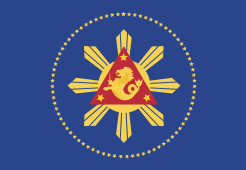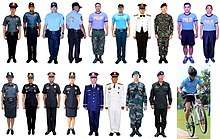Philippine National Police
The Philippine National Police (Filipino: Pambansang Pulisya ng Pilipinas, abbreviated PNP) is the armed, civilian national police force in the Philippines. Its national headquarters is at Camp Crame in Quezon City, Metro Manila, and it has 205,000 personnel.[4]
| Philippine National Police Pambansang Pulisya ng Pilipinas | |
|---|---|
 Insignia and uniform patch | |
 Badge | |
| Abbreviation | PNP |
| Motto | To Serve and to Protect |
| Agency overview | |
| Formed | January 29, 1991[1] |
| Preceding agencies |
|
| Annual budget | ₱187.33 billion (2020)[3] (US$3.72 billion) |
| Jurisdictional structure | |
| National agency | Philippines |
| Operations jurisdiction | Philippines |
| Operational structure | |
| Headquarters | Camp Crame, Quezon City |
| Police officers | 205,000 |
| Agency executives |
|
| Parent agency | Department of the Interior and Local Government via National Police Commission |
| Website | |
| www | |
It is administered and controlled by the National Police Commission and is part of the Department of the Interior and Local Government (DILG). Local police officers are operationally controlled by municipal mayors.[5] DILG, on the other hand, organizes, trains and equips the PNP for the performance of police functions as a police force that is national in scope and civilian in character.
The PNP was formed on January 29, 1991 when the Philippine Constabulary and the Integrated National Police were merged pursuant to Republic Act 6975 of 1990.[1]
History
Passed on December 13, 1990, Republic Act No. 6975, the Department of the Interior and Local Government Act of 1990 paved the way for a new era for Philippine law enforcement as the law ordered the total merger of both the Philippine Constabulary and the Integrated National Police and formally created the Philippine National Police.[6] R.A. 6975 was further amended by R.A. 8551, the Philippine National Police Reform and Reorganization Act of 1998,[7] and by R.A. 9708.[8] The R.A. 8551 envisioned the PNP to be a community- and service-oriented agency.
On June 14, 2019, the PNP announced that the Counter-Intelligence Task Force will be replaced with the Integrity Monitoring and Enforcement Group.[9]
Leadership

_Seal_-_Logo.svg.png)

- Deputy Chief for Administration of the Philippine National Police - PLt.Gen. Camilo Pancratius P. Cascolan
- Deputy Chief for Operations of the Philippine National Police - PLt.Gen. Guillermo Lorenzo T. Eleazar
- Chief of Directorial Staff - PLt.Gen. Cesar Hawthorne R. Binag
Organization
Operational units
Within the PNP operational units there are:[10]
- Aviation Security Group (AVSEGROUP)
This group provides security to all airports throughout the country.
This group is a mobile strike force or a reaction unit to augment regional, provincial, municipal and city police force for civil disturbance control, internal security operations, hostage-taking rescue operations, search and rescue in times of natural calamities, disasters and national emergencies and other special police operations such as ant-hijacking, anti-terrorism, explosives and ordnance disposal. On a special note, the PNP Air Unit is placed under the supervision of SAF.
This group monitors, investigates, prosecutes all crimes involving economic sabotage, and other crimes of such magnitude and extent as to indicate their commission by highly placed or professional criminal syndicates and organizations. It also conducts organized- crime –control, all major cases involving violations of the revised penal Code, violators of SPECIAL LAWS assigned to them such as Anti-hijacking, Anti-carnapping and Cyber crimes among others and atrocities committed by Communist Party of the Philippines (CPP)/New People's Army (NPA)/National Democratic Front (NDF).
This group is responsible to perform all police functions over Philippine territorial waters, lakes, and rivers along coastal areas to include ports and harbors and small islands for the security and the sustainable development of the maritime environment.
- Intelligence Group (IG)Philippine National Police boat on the Iloilo River, Iloilo City
This group serves as the intelligence and counter-intelligence op of the Crime Operatives (SOCO) This group provides scientific and technical, investigative aide and support to the PNP and other investigative agencies. It also provides crime laboratory examination, evaluation and identification of physical evidence gathered at the crime scene with primary emphasis on medical, biological and physical nature.
- Police Security and Protection Group (PSPG)
This group provides security to government vital installations, government officials, visiting dignitaries and private individuals authorized to be given protection.
- PNP Anti-Cybercrime Group (PNP-ACG)
This Group is responsible for the implementation of pertinent laws on cybercrimes and anti-cybercrime campaigns of the PNP.
- Police Community Affairs and Development Group (PCADG)
This group undertakes and orchestrates Police Community Relations program and activities in partnership with concerned government agencies, the community, and volunteer organizations in order to prevent crime and attain a safe and peaceful environment.
- Highway Patrol Group (HPG)
This group enforces the traffic laws and regulations, promote safety along the highways, enhances traffic safety consciousness through inter- agency cooperation concerning Police Traffic Safety Engineering, Traffic Safety Education and Traffic Law enforcement functions and develops reforms in the crime prevention aspect against all forms of lawlessness committed along National Highway involving the use of motor vehicles.
- Civil Security Group (CSG)
This group regulates business operations and activities of all organized private detectives, watchmen, security/agencies and company guard forces. It also supervises the licensing and registration of firearms and explosives.
- PNP Anti-Kidnapping Group (PNP-AKG)
This Group serves as the primary unit of the PNP in addressing kidnapping menace in the country and in handling hostage situations.
Internal Affairs Service
The PNP created a national Internal Affairs Service (IAS) on June 1999. It is an organization within the structure of the PNP and one of its tasks is to help the Chief institute reforms to improve the image of the police force through assessment, analysis and evaluation of the character and behavior of the PNP personnel. It is headed by the Inspector General.
Philippine National Police Academy
The Philippine National Police Academy is located at Camp Gen. Mariano N. Castaneda, Silang, Cavite and is the premier training academy for the Philippine National Police, Bureau of Jail Management & Penology and Bureau of Fire Protection.
National Operations Center (NOC)
The National Operations Center (NOC) is at Camp Crame. Chief Superintendent Constante Azares Jr., chief of the PNP-NOC, explained that "the NOC is the hub and nerve of this facility."[11]
Divisional organization
Regional Police Offices manage and administer Police Stations within the various regions of the Philippines, each of which include several provinces and independent cities. Each unit exercises independent control over all police units within their areas of operation and attached units of the PNP National Headquarters are ordered to assist these Regional Offices. The National Capital Region Police Office is one such regional office.
| Regional Offices | Area of Responsibility | Provincial/City Offices | Regional Director |
|---|---|---|---|
| National Capital Region Police Office (NCRPO) | National Capital Region – Metro Manila | 5 (All City Offices) | PMGen. Debold M. Sinas |
| Police Regional Office 1 (PRO1) | Region 1 – Ilocos Region | 4 | PBGen. Rodolfo S. Azurin Jr. |
| Police Regional Office 2 (PRO2) | Region 2 – Cagayan Valley | 6 (5 Provincials, 1 City) | PBGen. Angelito A. Casimiro |
| Police Regional Office 3 (PRO3) | Region 3 – Central Luzon | 9 (7 Provincials, 2 Cities) | PBGen. Rhodel O. Sermonia |
| Police Regional Office 4A (PRO4A) | Region IV-A – CALABARZON | 5 | PBGen. Vicente D. Danao Jr. |
| Police Regional Office 4B (PRO4B) | Region IV-B – MIMAROPA | 6 (5 Provincials, 1 City) | PBGen. Nicerio D. Obaob |
| Police Regional Office 5 (PRO5) | Region V – Bicol Region | 7 (6 Provincials, 1 City) | PBGen. Anthony S. Alcaneses |
| Police Regional Office 6 (PRO6) | Region VI – Western Visayas | PBGen. Rene P. Pamuspusan | |
| Police Regional Office 7 (PRO7) | Region VII – Central Visayas/ Cebu | 6 (4 Provincials, 2 Cities) | PBGen. Albert Ignatius D. Ferro |
| Police Regional Office 8 (PRO8) | Region VIII – Eastern Visayas/ Leyte | PBGen. Bernabe M. Balba | |
| Police Regional Office 9 (PRO9) | Region IX – Zamboanga Peninsula | 4 (3 Provincials, 1 City) | PBGen. Froilan T. Quidilla |
| Police Regional Office 10 (PRO10) | Region X – Northern Mindanao | 7 (5 Provincials, 2 Cities) | PBGen. Rolando B. Anduyan |
| Police Regional Office 11 (PRO11) | Region XI – Davao Region | 6 (5 Provincials, 1 City) | PBGen. Filmore B. Escobal |
| Police Regional Office 12 (PRO12) | Region XII – SOCKSARGEN / Bangsamoro barangays in North Cotabato[12] | 6 (4 Provincials, 2 Cities) | PBGen. Michael John F. Dubria |
| Police Regional Office 13 (PRO13) | Region XIII – CARAGA/ Butuan | 6 (5 Provincials, 1 City) | PBGen. Joselito T. Esquivel |
| Police Regional Office Bangsamoro Autonomous Region (PRO BAR)[12] | BARMM – Bangsamoro Autonomous Region in Muslim Mindanao and Cotabato City / Excluding Bangsamoro barangays in North Cotabato | 5 (All Provincial) | PBGen. Manuel M. Abu |
| Police Regional Office Cordillera (PRO COR) | Cordillera Administrative Region | 7 (6 Provincials, 1 City) | PBGen. R'Win SA Pagkalinawan |
Except in Metro Manila, regional police offices are organized into
- Provincial and Highly Urbanized City Police Offices
- Municipal/City Police Stations
- Police Substations
- Police Community Presincts
Rank Structure
Full set of ranks
Per the current (2019) rank system, the National Police has no rank holders of Second Lieutenant, Technical Sergeant, Sergeant and Patrolman First Class.
| Insignia | Rank[13] |
|---|---|
| Police General (PGEN) | |
| Police Lieutenant General (PLTGEN) | |
| Police Major General (PMGEN) | |
| Police Brigadier General (PBGEN) | |
| Police Colonel (PCOL) | |
| Police Lieutenant Colonel (PLTCOL) | |
| Police Major (PMAJ) | |
| Police Captain (PCAPT) | |
| Police Lieutenant (PLT) | |
| Police Executive Master Sergeant (PEMS) | |
| Police Chief Master Sergeant (PCMS) | |
| Police Senior Master Sergeant (PSMS) | |
| Police Master Sergeant (PMSg) | |
| Police Staff Sergeant (PSSg) | |
| Police Corporal (PCpl) | |
| Patrolman / Patrolwoman (Pat) |
Officers
Recruitment and training
_soldiers_descend_a_repel_tower_during_a_joint_U.S.-AFP-Philippine_National_Police_(PNP)_Subject_Matter_Expert_Exchange_(SMEE).jpg)
The PNP conducts regular recruitment programs, depending on the annual budget. The entry level for non-commissioned officers is the rank of Police Patrolman (for male recruits) or Police Patrolwoman (for female recruits). The new recruits will undergo Public Safety Basic Recruit Course for six months, and a Field Training Program for another six months. Prior to their actual duty, they are required to undergo the mandatory special training of PNP SCOUT or PNP Special Counter-insurgency Unit Training course for 45 days to 5 months to enhance them in militaristic/tactics for future assignment in the field whether in the Striking Force or in the Police Station.
Commissioned officers for the Philippine National Police are from the Philippine National Police Academy as well as through "lateral entry" for specialized disciplines and requirements such as criminologists in line-officers, lawyers, doctors, engineers, chaplain and other technical positions and also the rose-from-the-rank personnel who have reached the qualifications to be a commissioned officer.
Retirement
A police officer has to retire from the PNP when they reach the mandatory retirement age of 56. Any officer may opt to go on non-duty status at most three months before the date when they reach the mandatory retirement age so they could prepare the pertinent documents for their retirement. While on this status they are still considered as part of the police force and retains their ranking.[14]
Equipment

PNP officers are equipped with Beretta 92 and Glock pistols. Their assault rifles used were M16 and M4A1 rifles and were used by SWAT Teams and the Special Action Force (SAF). Submachine guns used were the MP5 and UMP45. Shotguns used are the Remington 870 and the Mossberg 590. Recently, PNP have add the IWI Masada from Israel.
Controversies
Manila blackmail incident
A blackmail case occurred in Binondo, Manila when police officers abducted and blackmailed seven Chinese citizens suspected of drug trafficking on December 30, 1998.[15] After many months of detainment and torture, two Hong Kong residents were killed when the ransom money was not paid.[16] One police superintendent who knew of the operation was also killed.[15]
Euro Generals scandal
The Euro Generals scandal involves Eliseo de la Paz and several Philippine National Police officials who went to Russia on October 2008 to attend an Interpol conference. De la Paz was detained for carrying a large sum of undeclared money. A House panel investigating the scandal concluded that the six police officials who attended the conference had made the trip illegally.[17] In 2010, the Office of the Ombudsman filed graft charges against twelve former and active ranking PNP officials for their alleged involvement in the incident.[18][19]
Parañaque shootout
On December 5, 2008, ten suspected criminals, one policeman, and five civilians, a total of 16 people, including a seven-year-old girl, were killed in a bloody shootout in Parañaque. Several others were wounded, including a ranking officer of the Highway Patrol Group, two members of the Special Action Force, a village watchman, and a security guard, said Director Leopoldo Bataoil, head of the Metro Manila regional police. The criminals belonged to a Waray-Waray gang and were armed with high-caliber M16 rifles fitted with grenade launchers.[20]
The head of the Internal Affairs Service of the PNP said, "We failed in our mission to protect the civilians. Because during the conduct of operation many civilian lives were lost,"[21] On July 29, 2009, it was reported that the Department of Justice (DOJ) had filed multiple murder charges against 29 policemen, including three generals, in connection with the shootout following the filing of a complaint-affidavit by Lilian de Vera, who lost her husband and daughter, age seven, in the incident.[22] On January 11, 2010, the Commission on Human Rights recommended the filing of criminal and administrative charges against 26 policemen[23] In March, it was reported that after two witnesses had said De Vera and his daughter were not killed in the shootout, that policemen already had complete control of the area where the two were killed, the Department of Justice filed two counts of murder charges against 25 policemen for the killings.[24]
Binayug torture case
Inspector Joselito Binayug, chief of the Asuncion police community precinct in Tondo arrested Darius Evangelista on March 5, 2009 for alleged robbery. A torture video was leaked to the media and shown on television showing a police officer whipping and cursing the suspect and pulling on a rope that was tied to the victim's genitals. The incident allegedly happened inside the Asuncion police precinct in Tondo. Binayug was arrested for violating the Anti-Torture act of 2009. Separate charges were filed for Evangelista being tortured to death.[25][26]
Maguindanao massacre
On November 24, 2009, Senior Superintendent Abusana Maguid, the police chief of Maguindanao province, was reported to have been relieved of his duties after witnesses reported seeing three of his officers at the scene of the Maguindanao massacre in which 57 people, including journalists, lawyers, aides, and motorists who were witnesses were killed.[27] On November 25 Maguid and Chief Inspector Sukarno Dikay were reported to have been relieved from post and placed under restrictive custody.[28] On November 26, Department of the Interior and Local Government (DILG) Secretary Ronaldo Puno announced that Maguid, Dikay, and others were suspected of involvement in the massacre.[29] On December 19, Maguid, Dikay, and others were reported to have been recommended for summary dismissal by the PNP high command.[30] On April 16, 2010, the National Police Commission ordered a 90-day suspension against Maguid, Dikay, and 60 other police personnel for their possible involvement in the killings.[31] On July 10, it was reported that Dikay had applied to become state witness, saying that he is confident that his testimony will pin down the masterminds of the killing.[32]
Failed hostage rescue operation
The Philippine National Police conceded that in the 2010 Manila hostage crisis they made blunders in ending a bus hijacking, as outrage grew over the bloody assault played out on live television that left eight Hong Kong tourists dead. The Hong Kong Economic Journal was reported to have accused the PNP of having "appalling professional standards" and "...[a] lack of strategic planning".[33]
"Wheel of Torture" secret detention facility
The Philippine Commission on Human Rights filed charges against ten police officers after it was discovered that they routinely tortured detainees inside a secret detention facility in Biñan, Laguna. The facility was maintained by the PNP Provincial Intelligence Branch (PIB) to extract confessions or information from detainees, or to extort money from them in exchange for being charged with lighter offenses or the dropping of the charges altogether. It was also alleged that some "were tortured for the police officers’ amusement" when they're intoxicated. The facility is notorious for utilizing a roulette called the "Wheel of Torture", a play on the Wheel of Fortune, where various torture methods were printed. The wheel is rotated and wherever the pin stops, the indicated torture method is perpetrated on the detainee.[34][35]
The torture methods included, a 20-second Manny Pacman punch, named after the famous boxer Manny Pacquiao, where the detainee is beaten for 20 seconds; "Paniki" which means being hung like a bat; "Tusok ulo ka" which means being pierced through the head; "Zombies" which means being electrocuted; and other degrading tasks like "duck walk" and "Ferris wheel".[35][36]
Kidnapping and killing of Jee Ick-Joo
Sometime in January 2017, a Korean was killed inside Camp Crame.[37][38] The Philippine National Police Anti-Kidnapping Group (PNP-AKG) charged former NBI officials Roel Boliv, Ricardo Diaz, and Jose Yap in relation to the case.[39]
See also
References
- About the Philippine National police Archived March 26, 2012, at the Wayback Machine
- Hurley, Vic (2011). Jungle Patrol, the Story of the Philippine Constabulary (1901–1936). Cerberus Books. p. 60. ISBN 9780983475620 – via Google Books.
Section 1. An Insular Constabulary is hereby established under the general supervision of the Civil Governor for the purpose of better maintaining peace, law, and order in the various provinces of the Philippine Islands, organized, officered and governed as hereinafter set forth, which shall be known as the Philippines Constabulary.
- Aika Rey (January 8, 2020). "Where will the money go?". Rappler. Retrieved May 29, 2020.
- "Top Philippine cop resigns after accusation of link to drug scandal". Reuters. October 14, 2019. Retrieved October 25, 2019.
- Except during the 30 days immediately preceding and following any national, local and barangay elections. During these periods, the local police forces are under the supervision and control of the Commission on Elections
- "Republic Act No. 6975". Official Gazette of the Republic of the Philippines. December 13, 1990. Retrieved June 13, 2020.
- "Republic Act 8551". Philippine Commission on Women. February 25, 1998. Retrieved June 13, 2020.
- "Republic Act No. 9708". Official Gazette of the Republic of the Philippines. August 12, 2009. Retrieved June 13, 2020.
- "PNP to replace CITF with IMEG to monitor corrupt cops – UNTV News". UNTV News. June 14, 2019. Retrieved April 15, 2020.
- "About the Philippine National Police". Archived from the original on July 9, 2016. Retrieved July 1, 2016.
- ABS-CBNnews.com, PNP unveils state-of-the-art operations center
- Unson, John (March 25, 2019). "Cotabato City cops can join BARMM or transfer to PRO-12". The Philippine Star. Retrieved March 26, 2019.
The PRO-BARMM, originally PRO-ARMM, covers Maguindanao and Lanao del Sur, both in mainland Mindanao, and the island provinces of Basilan, Sulu and Tawi-Tawi.
- Sadongdong, Martin (March 26, 2019). "Modified PNP rank classification takes effect". Manila Bulletin. Retrieved March 28, 2019.
- Felipe, Cecille Suerte; Tupas, Emmanuel (October 14, 2019). "Albayalde goes on 'non-duty' leave". The Philippine Star. Retrieved October 21, 2019.
- Newsinfo.inquirer.net. "Newsinfo.inquirer.net Archived 2010-08-30 at the Wayback Machine." Acting MPD chief facing raps over abduction of HK residents. Retrieved on August 28, 2010.
- HKdailynews.com.hk. "HKdailynews.com.hk Archived 2011-10-06 at the Wayback Machine." 新任警察總長一天下台 涉綁架謀殺3港人. Retrieved on August 28, 2010.
- Jess Diaz, Moscow trip illegal – PNP, The Philippine Star, November 21, 2008.
- Kristine L. Alave, Alcuin Papa, Ombudsman says ‘euro generals’ lied Archived August 15, 2010, at the Wayback Machine, Philippine Daily Inquirer, August 13, 2010.
- Michael Punongbayan, 'Euro generals' charged with graft, The Philippine Star, August 13, 2010.
- Ramos, Marlon (December 7, 2008). "Girl, 7, among 16 killed in shootout". Philippine Daily Inquirer. Archived from the original on December 8, 2008. Retrieved May 7, 2020.
- Parañaque shootout a failed operation – police internal affairs head, GMA News, December 10, 2008.
- Multiple murder raps filed vs cops in Paranaque shootout, datelinephilippines.com, July 29, 2009.
- CHR wants cops in Parañaque shootout charged, ABS-CBN News, January 12, 2010.
- DOJ files murder raps vs 25 cops in Parañaque shootout, ABS-CBN News, March 11, 2020.
- Philstar.com, Tondo precinct cops face torture raps
- Philstar.com, Torture victim identified
- Philippine Local Police Chief Detained After Massacre, Bloomberg.com, November 24, 2009.
- Paolo Romero, State of emergency in Maguindanao, The Philippine Star, November 25, 2009.
- Maguindanao massacre suspect turns self in, ABS-CBN News, November 26, 2009.
- 7 policemen face dismissal over 'neglect' in Maguindanao massacre, GMA News, December 19, 2009.
- 5 Ampatuans moved to Manila jail, Sun-Star, April 17, 2010.
- Aie Balagtas, Andal Jr., 16 others plead not guilty, The Philippine Star, July 29, 2010.
- Channel NewsAsia – Philippine police admit blunders in deadly hostage ordeal
- "Police Torture Chamber Found in Laguna". Inquirer.net. Retrieved January 30, 2014.
- "Philippine police accused of using "wheel of torture"". NYPost. Retrieved January 30, 2014.
- "Filipino cops accused of "Wheel of Torture"" Archived February 1, 2014, at the Wayback Machine. NewsBeat Social. Retrieved January 30, 2014.
- "Murder in Crame: Senate probes Korean kidnap-slay case". Rappler. Retrieved April 19, 2018.
- "Judge handling kidnap-slay case of Korean Jee Ick Joo inhibits himself". Manila Bulletin News. Retrieved April 19, 2018.
- "Former NBI officials charged in Korean kidnap-slay case". Rappler. Retrieved April 19, 2018.
External links
| Wikimedia Commons has media related to Philippine National Police (PNP). |
